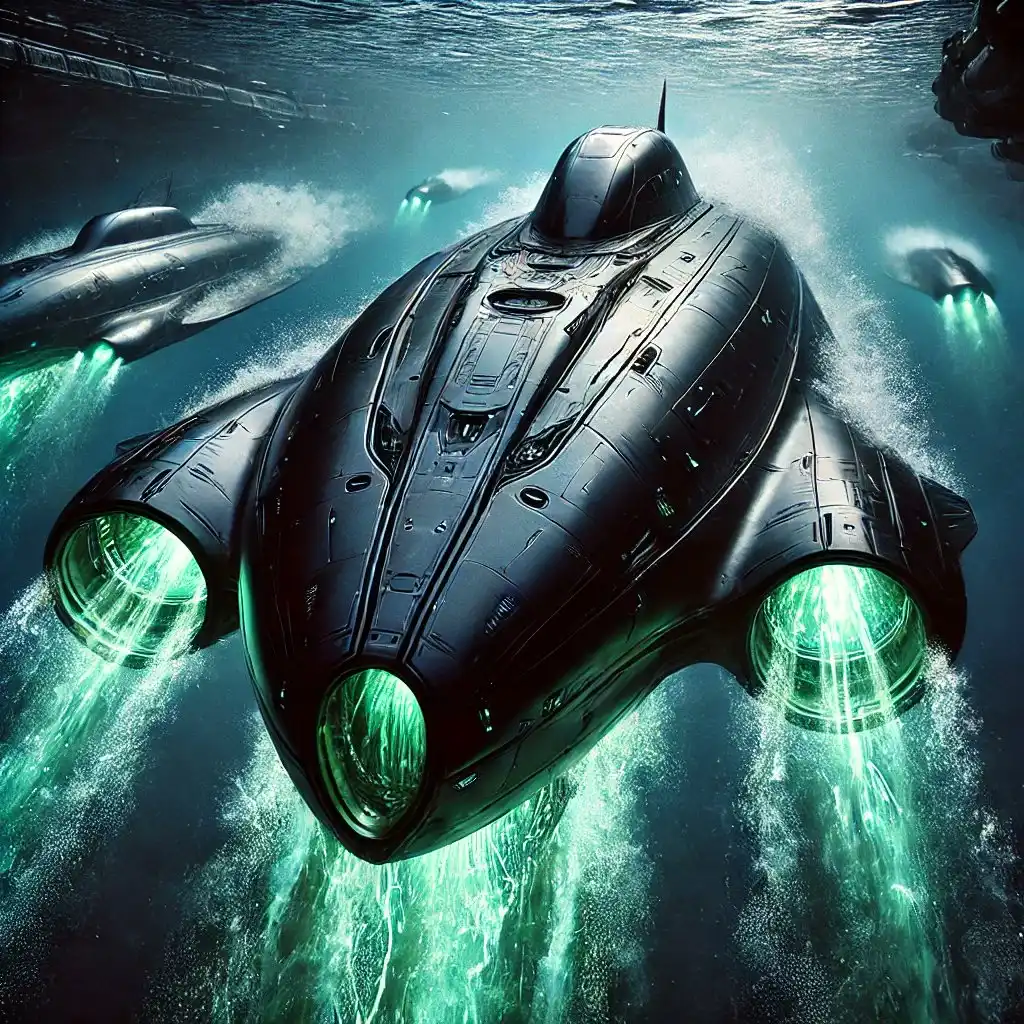Table of Contents
Executive Summary
Introduction
Foundations
The Ultimate Pod: Design, Features, and Capabilities
Analytical Strengths in Military Science
Technological Innovations: A Deeper Exploration
Strategic Vision
Implementation Roadmap
Socio-Economic and Environmental Considerations
Legal and Ethical Dimensions
Conclusion

1. Executive Summary
-
Ultimate Stealth: Radar-absorbing materials, sonar-dampening propulsion systems, and IR signature management ensure near-total invisibility.
-
Multi-Domain Strike Capability: Modular payloads (e.g., hypersonic missiles, torpedoes, anti-satellite systems) expand the TSP’s effectiveness in underwater, surface, air, and even space-based engagements.
-
Decentralized Resilience: A dispersed network of TSPs reduces the risk of catastrophic loss and ensures continuous operations under the harshest conflict scenarios.

2. Introduction
2.1 Problem Statement
-
Visibility and Vulnerability: Large vessels are vulnerable to precision-guided munitions, hypersonic missiles, and advanced surveillance.
-
Economic Strain: Massive fleets consume enormous defense budgets, diverting capital from research, education, and healthcare.
-
Environmental and Diplomatic Complexities: High-intensity naval operations can damage delicate marine ecosystems and strain international relations, especially in contested waters like the Arctic or South China Sea.
2.2 A 21st-Century Vision of Security & Innovation
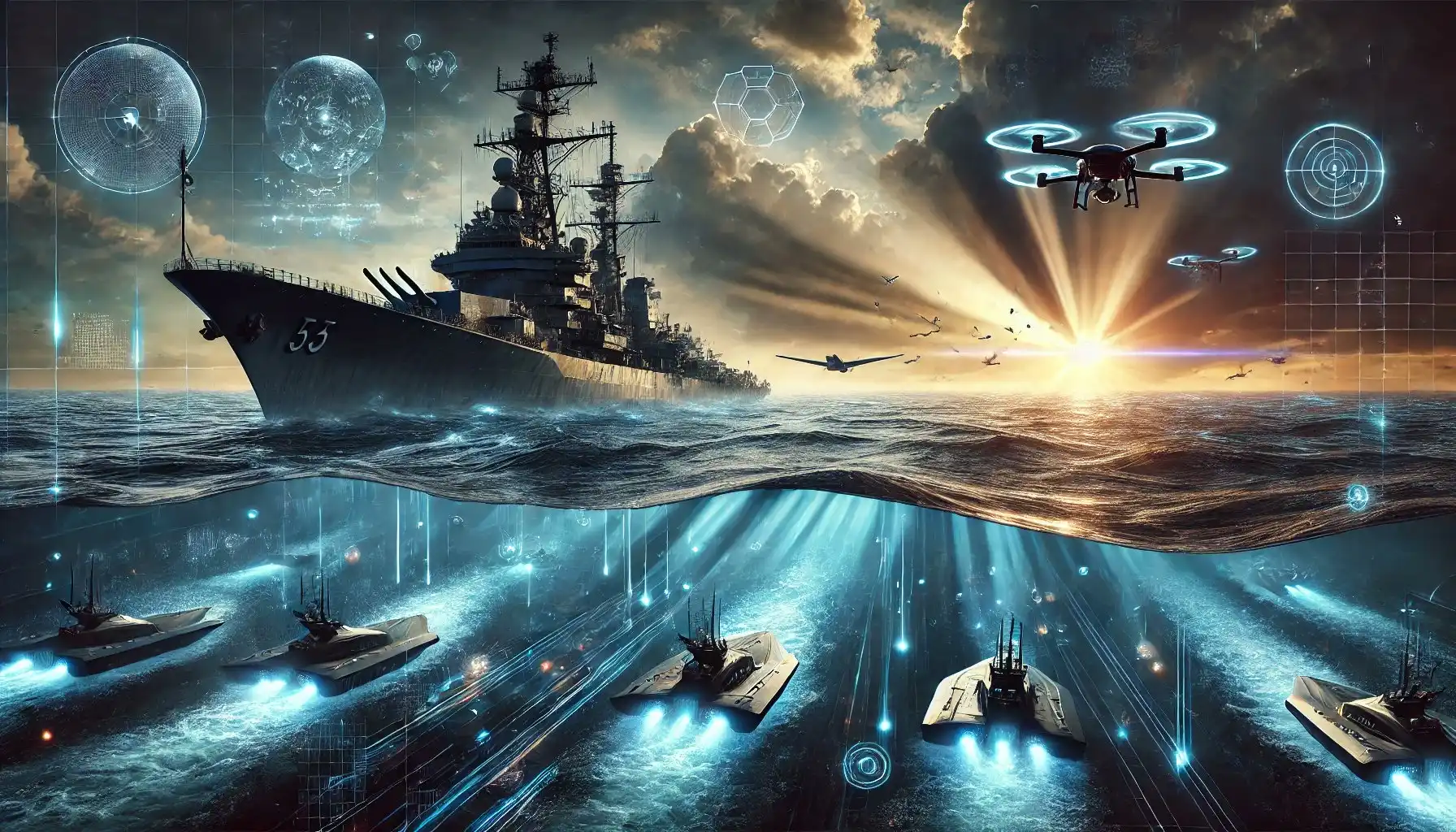
3. Conceptual Foundations
The Transoceanic Stealth Pod (TSP) Network is, at its core, a bold departure from traditional naval doctrine. To fully understand why these small, stealthy pods could be so transformative, it’s important to trace the intellectual heritage that shaped them. Over the last century, military strategists have championed the idea that large, heavily armed fleets are the ultimate arbiters of control at sea. Figures such as Alfred Thayer Mahan famously argued that dominating sea lanes with formidable battleships was the key to national power. While that vision made sense in the age of dreadnoughts and aircraft carriers, warfare in the 21st century demands a more nuanced and adaptive approach.
Recent developments have fundamentally reshaped the strategic environment. We live in an era when hypersonic missiles can strike warships before they have time to react, where satellite reconnaissance covers every corner of the globe, and where drones — often cheaper than a single naval missile — can be deployed by the thousands. Traditional maritime battle groups, comprising massive aircraft carriers and their escorting vessels, still project power impressively, but they also carry considerable risks. A single carrier’s visibility makes it a high-priority target, and losing it would be a strategic disaster. Adversaries seeking to counter these imposing fleets now invest heavily in Anti-Access/Area Denial (A2/AD) measures, making large-scale maritime operations increasingly hazardous and expensive.
Against this backdrop, the TSP Network represents a paradigm shift. Instead of prioritizing bigger ships, it emphasizes a distributed network of smaller, near-invisible platforms that rely on technology rather than bulk. Each TSP is designed to operate autonomously for extended periods and remain hidden from prying eyes. This means that an opposing force confronting the TSP Network must contend with not just one large target but a vast array of highly resilient, interconnected pods. The foundational thinking here builds on evolving doctrines such as Multi-Domain Battle and Distributed Maritime Operations — both of which stress flexibility, advanced surveillance, and rapid response over raw firepower.
This approach to defense has a profound side benefit: by focusing on decentralized systems that are smaller and more specialized, nations like Canada can avoid bankrupting their budgets on giant carriers or destroyers. Instead, resources can be channeled into cutting-edge science, engineering, AI, and sustainable energy — fields that not only strengthen defense but also generate wider economic and technological benefits. In a sense, the TSP Network stands as more than a new piece of hardware;it’s an embodiment of how innovative thinking — rooted in historical lessons but open to modern possibilities — can redefine the very nature of maritime security.
3.1 Historical Antecedents: From Mahan to Multi-Domain Battle
-
Alfred Thayer Mahan:Argued that naval dominance relies on large surface fleets to control sea lanes.
-
Distributed Maritime Operations (DMO) & Multi-Domain Battle:Contemporary doctrines focus on flexible, networked, and smaller-scale platforms to outmaneuver large, centralized adversary forces.
-
A2/AD (Anti-Access/Area Denial):Nations developing ballistic and cruise missiles that threaten large ships, prompting a pivot toward stealthy, smaller units.
3.2 Emerging Doctrines and Technological Revolutions
-
Autonomous Swarm Warfare: Advances in AI and robotics have enabled swarms of small, decentralized platforms. The TSP extends this logic below the waves and across the entire maritime domain.
-
Hypersonic Weaponry:Speeds exceeding Mach 5 reduce reaction times to seconds, favoring stealthy, rapid-response platforms like TSPs.
-
Sustainability and Renewables:Next-generation defense strategies increasingly emphasize reduced ecological impact. TSPs incorporate advanced batteries and wave/solar harvesting for long-duration missions.
4. The Ultimate Pod: Design, Features, and Capabilities
To picture a Transoceanic Stealth Pod, you might start by imagining something that looks more like a sleek, submersible machine than a conventional submarine. Its outer hull, a composite of cutting-edge metamaterials and bio-inspired shapes, is designed to trick even the most advanced radar and sonar systems. This hull may subtly shift its coloration or texture, blending with the seafloor or open ocean. Internally, nearly every centimeter is optimized for stealth, power efficiency, and mission-specific equipment, with very little wasted space for anything but the essentials.
At the heart of the TSP is a propulsion system that borders on science fiction:magnetohydrodynamic (MHD) drives. Instead of relying on spinning propellers or mechanical shafts, an MHD drive uses electric and magnetic fields to push seawater through a channel, generating thrust almost silently. The whirring gears and hum of engines that typically alert sonar arrays to the presence of a submarine are replaced by a hushed flow of water. To further minimize acoustic signatures, the TSP is lined with sound-dampening materials that absorb and diffuse residual noise. Together, these innovations give the TSP an extraordinary advantage in remaining undetected.
Yet stealth alone would mean little if these pods lacked offensive and defensive power. Here is where the TSP’s modular design truly shines. Each unit can be quickly configured with different payloads. One might be armed with hypersonic missiles, capable of hitting distant targets at speeds exceeding Mach 5 or higher. Another might carry advanced torpedoes or anti-submarine munitions to assert dominance beneath the waves. Others may forgo kinetic weapons altogether, relying on sophisticated electronic warfare suites to jam enemy sensors or disrupt communications. There’s even room for more specialized modules, such as anti-satellite payloads — an increasingly relevant capability when conflicts can unfold just as much in orbit as they do at sea level.
Driving all of these capabilities is a suite of onboard artificial intelligence. Before the TSP even leaves port, its AI has already consumed terabytes of data from past operations, environmental models, and open-source intelligence on potential adversaries. Once deployed, it navigates the oceans autonomously, relying on real-time processing to dodge sonar nets and plan routes around weather patterns and shipping lanes. If one pod detects a threat, it can instantly relay that information to the others, forming a decentralized “swarm intelligence” that dynamically adapts to changing missions. And because the TSPs harvest energy from waves and sunlight (through small, retractable solar arrays), they can remain operational for long durations without returning to port, making them a constant and elusive presence wherever they’re deployed.
Thinking of a TSP Network in action, it’s easy to see why it could rewrite the rules of naval engagement. Instead of large carriers broadcasting their location on every horizon, a quiet legion of smaller pods roam far-flung waterways, always on the lookout, always gathering data, and always ready to respond. They embody a philosophy that prizes agility over brute force, surprise over sheer volume of fire, and adaptability over static positioning. And this philosophy, in turn, is a testament to the brilliant minds in materials science, propulsion engineering, AI research, and military strategy — each bringing their own discoveries and breakthroughs together in a single, elegant platform that could transform maritime defense for generations to come.
4.1 Core Design Philosophy
4.2 Stealth and Signature Management
-
Radar Absorption & Deflection: Advanced Composites:Carbon nanotubes, metamaterials, and radar-absorbent coatings. Low-Observable Geometries: Faceted or curved designs that minimize radar cross-section (RCS).
-
Sonar-Dampening Propulsion: Magnetohydrodynamic (MHD) Drives:Eliminating mechanical drive shafts and propellers drastically reduces acoustic output. Acoustic Dampening Tiles:Inspired by submarine quieting techniques, further lowering the vessel’s detectable noise signature.
-
Thermal & Infrared (IR) Management:Heat Exchangers: Efficiently disperse or store heat to minimize IR spikes. Adaptive Camouflage: Active materials that shift patterns to blend with ambient oceanic or surface conditions.
4.3 Modular Payloads and Multi-Domain Strike
-
Hypersonic Missiles:Precision engagement of air, land, sea, and even near-space targets.
-
Torpedoes:Lightweight, high-speed underwater munitions for anti-submarine and anti-ship warfare.
-
Anti-Satellite (ASAT) Systems:Kinetic or directed-energy methods to disable adversary satellites.
-
Electronic Warfare Packages:Jammers, decoys, and electromagnetic pulse (EMP) devices to disrupt enemy C4ISR (Command, Control, Communications, Computers, Intelligence, Surveillance, Reconnaissance).
4.4 AI-Driven Autonomy and Distributed Networking
-
Machine Learning & Swarm Intelligence:TSPs share sensor data and combat intelligence in real time, making coordinated decisions without centralized control.
-
Edge Computing:Onboard AI processes data locally, reducing latency and ensuring TSPs remain fully functional even if satellite links are lost.
-
Adaptive Mission Profiles:AI reconfigures the TSP’s payload, trajectory, and response protocols based on changing threat landscapes.
4.5 Sustainable Energy and Endurance
-
Wave Energy Harvesters:Harnessing oceanic wave motion to trickle-charge onboard batteries.
-
Solar Photovoltaics:Surface-mounted or deployable panels that supplement energy needs.
-
Advanced Batteries:Solid-state, high-density power storage with rapid recharging and enhanced safety profiles.

5. Analytical Strengths in Military Science
One way to understand the transformative power of the Transoceanic Stealth Pod Network is by exploring how it reshapes today’s battlefield. Traditional naval strategies often look like an arms race of escalating scales: bigger ships bristling with more weapons, advanced fighter jets, and powerful missiles. At first glance, these giant fleets seem unstoppable, projecting an aura of dominance that has defined maritime power for decades. But the TSP Network disrupts this old paradigm by leveraging intelligence, stealth, and strategic subtlety.
Imagine a conflict scenario in which large carriers and destroyers traverse open waters, easily tracked by satellites or long-range sensors. By contrast, TSPs slip beneath the waves or skim just below an adversary’s radar horizon. Each one, operating independently, rarely offers the kind of signature that would justify a full-blown attack, and yet collectively, these pods could pack a formidable punch. Their unpredictability forces an adversary to expend enormous resources just attempting to locate them. It’s like having a thousand hidden snipers in a forest rather than a single fortress on a hill: you never know where the threat might emerge.
For smaller nations or those looking to optimize defense budgets, this decentralized resilience is a game-changer. Large fleets require astronomical spending— not just in construction, but also in staffing, fuel, and ongoing maintenance. The TSP, by contrast, operates at a fraction of the cost and can stay deployed for weeks or months without needing a return to port. Its collective presence, spread out across vast maritime zones, disrupts an adversary’s entire approach to sea control.
And then there’s the speed factor. Integrating hypersonic missiles — or potentially directed-energy weapons — into a TSP’s toolkit compresses reaction times to mere seconds.An enemy vessel or aircraft might detect a TSP only when it’s already too late: by the time the data is processed and a response is formulated, a hypersonic strike could be inbound at thousands of miles per hour. This lethal efficiency further erodes the value of large ships, which function as massive targets under increasingly limited reaction windows.
Yet the real genius of the TSP Network isn’t just in how it knocks down old assumptions. It’s in how it encourages fresh perspectives on what maritime security looks like — perspectives that value flexibility, speed, and information over overwhelming firepower. In this sense, the TSP becomes not merely a tool but a catalyst, prompting entire navies, governments, and engineers to revisit how they define and achieve national security at sea.
5.1 Decentralized Resilience and Disruption of Traditional Navies
-
Limits Single-Point-of-Failure:Even if one or several TSPs are destroyed, the network remains operational.
-
Forces Adversary Resource Overextension:Tracking and neutralizing widely dispersed, stealthy pods is prohibitively expensive and complex.
5.2 Speed-of-Light and Speed-of-Sound Gaps: Hypersonic Integration
-
Near-Instantaneous Engagement Windows:Hypersonic speeds shrink adversary reaction times from minutes to mere seconds.
-
Layered Defense:Directed-energy intercepts inbound missiles, while TSP-launched hypersonic munitions neutralize surface or air threats.
5.3 Neutralizing Detection Technologies
-
Sonar:MHD propulsion and acoustic dampening disrupt standard submarine-hunting techniques.
-
Radar/EM:Metamaterials and polygonal designs drastically reduce RCS.
-
Infrared:Heat-dispersion systems and oceanic cooling keep IR signatures negligible.
5.4 Strategic Versatility Across Domains
-
Coastal Defense: TSPs can patrol littorals silently, intercepting intrusions.
-
Open-Ocean Force Projection: Pods scattered across chokepoints (e.g., Strait of Malacca, Suez Canal) maintain security and deter threats.
-
Polar Regions: Ice-hardened versions protect Arctic lanes, vital as melting icecaps open new routes.

6. Technological Innovations
Peeling back the layers of the Transoceanic Stealth Pod is like stepping into a blueprint for the future of engineering. The pods themselves are crafted from advanced composites that fuse structural strength with the elusive properties of metamaterials — substances whose surfaces absorb, scatter, or shift electromagnetic waves in ways that keep the vessel hidden. However, it’s inside that these stealth pods truly shine.
No propellers clang against the water. Instead, you find magnetohydrodynamic (MHD) propulsion systemsquietly pushing the pods along. It’s an elegant solution that bypasses the usual turbulence and mechanical noise created by conventional machinery. The ocean becomes a near-frictionless medium in which these pods glide with minimal acoustic signatures, making them extraordinarily difficult to detect via sonar. Sound-dampening interiors further reduce any leftover operational noise, reinforcing the TSP’s ability to exist below the detection threshold.
Equally vital to the TSP’s design is the onboard artificial intelligence. Picture a compact supercomputer that not only runs autonomous navigation routines but also serves as the pod’s digital brain, absorbing sensor data, mapping out safe routes, and orchestrating real-time responses to new threats. These AI modules operate on a principle of swarm intelligence: any insight gained by one TSP — be it a reading of enemy radar frequencies or the detection of a submarine’s acoustic signature — is shared securely with the rest.This collective mind elevates each pod into something greater than just a lone stealth craft; it becomes a cell within a self-learning, ever-evolving network.
Energy management, too, illustrates how every detail of the TSP resonates with forward-thinking design. Solid-state batteries power its internal systems without the risks associated with older battery technologies. Solar arrays, when the pod surfaces, and wave-energy harvesters, when it submerges, recharge these batteries. In essence, a well-designed TSP can roam the seas indefinitely, rarely requiring a resupply port. Where some might see a war machine, engineers and scientists see a testbed for sustainable energy solutions— technologies that could one day find applications in commercial shipping, deep-sea research, and remote oceanic outposts.
Finally, the TSP’s payload systems highlight its multi-domain prowess.
Hypersonic missiles offer near-instantaneous threat neutralization, while specialized torpedoes and anti-submarine munitions secure undersea dominance.
Additionally, TSPs can deploy missiles designed to strike land-based military assets with precision, intercept airborne threats like fighter jets, or counter ballistic missiles through advanced anti-missile capabilities. In the realm of satellite warfare, some TSP variants might carry energy weapons or kinetic “dart” systems to target orbiting assets.
Others might carry non-lethal electronics packages — jammers, decoys, and EMP generators — to scramble hostile systems without triggering large-scale conflict. It’s a potent combination of stealth, speed, and selective force that speaks to how the TSP enables nations to scale their defense postures responsibly and precisely.
In the grand tapestry of modern engineering and defense innovation, each technological strand — stealth materials, silent propulsion, autonomous AI, renewable power, and rapid-strike weapons — works in concert to create something altogether new. It’s a vision of how the frontiers of science and strategy can converge on the ocean’s surface (and just below it), challenging the assumptions of yesteryear and inspiring a new generation of thinkers to reimagine what’s possible in maritime security.
6.1 Materials Science and Advanced Composites
-
Reference: Kim, S. et al. (2022). Metamaterial Innovations for Naval Applications, Journal of Advanced Composite Research, 45(3): 215–235.
6.2 Magnetohydrodynamic (MHD) Propulsion and Noise Reduction
-
Reference: Ghasemi, A., & Li, Y. (2021). High-Temperature Superconductors in Maritime Propulsion Systems, International Review of Naval Science, 12(2): 99–113.
6.3 Artificial Intelligence: Machine Learning, Swarm Coordination, and Edge Computing
-
Swarm Coordination:AI algorithms mimic insect societies (e.g., ants, bees) for distributed decision-making.
-
Reinforcement Learning:TSPs learn from simulated battles, refining tactics in real-time.
-
Cybersecurity by Design:Quantum-resistant encryption ensures safe data links among pods.
-
Reference:DARPA. (2020). Collaborative Autonomous Systems: Swarm AI Research, US Defense Advanced Research Projects Agency White Paper.
6.4 Hypersonic Weapons, Directed Energy, and Electromagnetic Maneuvers
-
Hypersonic Flight:Speeds above Mach 5 challenge existing anti-missile defenses and require advanced guidance (e.g., inertial navigation + AI-based mid-course correction).
-
Directed Energy:Solid-state lasers or microwave systems installed in TSPs provide rapid, precise engagements without conventional munitions.
-
Reference: Oelrich, I. (2023). Hypersonic Trajectories and Targeting in Naval Warfare, Proceedings of the Institute of Aeronautics and Astronautics, 78(4): 311–326.
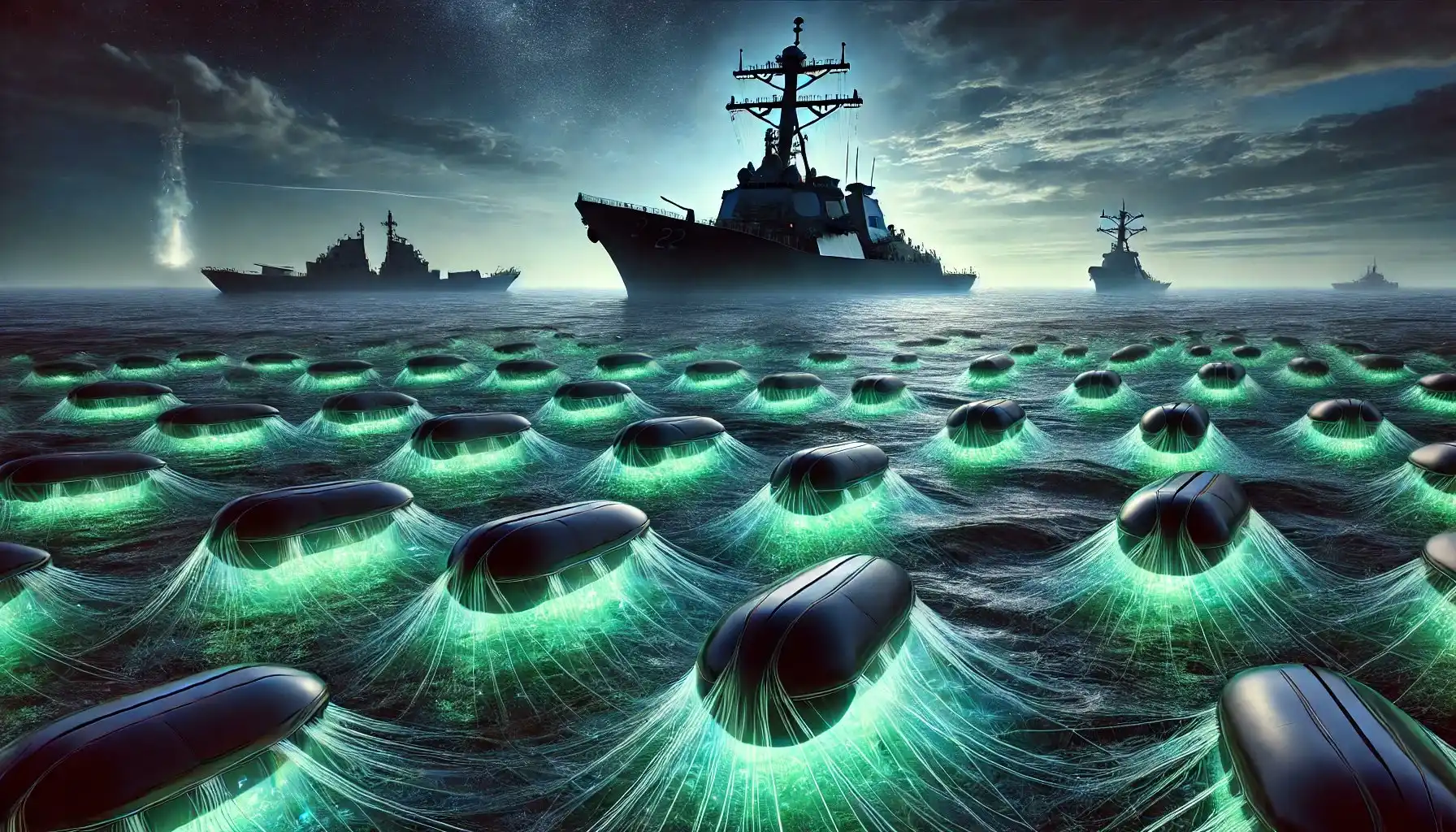
7. Strategic Vision
The Transoceanic Stealth Pod Network offers more than just an arsenal of advanced technology; it invites us to rethink what maritime security means in the 21st century. Consider, for a moment, the way large carriers and destroyers have long symbolized a nation’s power on the seas. Their towering silhouettes and well-publicized firepower broadcast a message of dominance wherever they sail. Yet this approach, while awe-inspiring, also comes with monumental expenses in both capital and manpower. Worse still, it draws clear lines of conflict — if an adversary wants to strike, they know exactly where to aim.
By contrast, the TSP Network envisions a subtler yet more resilient form of deterrence: stealth pods spread across oceans, rarely showing themselves unless a threat arises. In this model, security is woven into the very fabric of maritime routes. A would-be aggressor can no longer rely on a few key hits to cripple a nation’s navy. Instead, they face a fluid web of small yet capable units, each one equipped to detect, communicate, and, if necessary, neutralize any hostile force. The deterrent value here is psychological as well as physical. In effect, the TSP Network turns a country’s coastlines — and even open oceans — into something akin to a stealth fortress that doesn’t need walls.
Such a strategic vision also extends beyond purely military aims. Because each stealth pod operates with an unusually light footprint — harvesting energy from waves and sunlight, moving silently beneath the surface — it can take on roles that are harder to justify with massive warships. From monitoring environmental shifts and illegal fishing to providing early-warning data on hurricanes or tsunamis, these pods can be reconfigured to act as guardians of both human interests and marine ecosystems. Imagine, for instance, a TSP that delivers emergency supplies to a coastal region struck by natural disaster, or a network of TSPs mapping rising water temperatures to track climate change. By blending defensive power with broad utility, the Network reframes naval technology as an agent of global responsibility rather than sheer force.
Central to this vision is the idea that security and progress need not be at odds. The TSP Network encourages a shift in national priorities — from pumping ever-larger budgets into hardware built solely for conflict to channeling resources into innovation, research, and collaborative ventures. When pods can be repurposed for humanitarian missions or climate science, public support for maritime spending naturally grows. Nations begin to see that their coastal defenses can double as platforms for environmental stewardship, fostering partnerships that once seemed unthinkable in a purely military context.
In the end, the TSP Network’s true strength may lie in this holistic view of what security means. Rather than boxing naval power into a single role—stand by for war — it empowers communities, scientists, and decision-makers to explore how advanced marine technology can serve humanity in multiple ways at once. Whether deterring aggression, preserving peace, or studying the depths of the ocean, the TSP Network turns what might otherwise be a new round in an arms race into a leap forward for maritime science and collective well-being.
7.1 Redefining Warfare: Distributed Lethality and Strategic Deterrence
-
Cost Asymmetry:Deploying TSPs is far cheaper than building and maintaining aircraft carriers or large destroyers, leveling the playing field for mid-tier powers like Canada.
-
Strategic Deterrence: Uncertainty about TSP locations and capabilities forces potential aggressors to consider the prohibitively high risks of maritime invasion or blockade.
7.2 Beyond Military Applications: Environmental Monitoring, Disaster Relief, and Research
-
Climate & Pollution Tracking:TSPs carry sensor modules to measure ocean acidification, temperature changes, and pollutant levels, building a real-time global map of ocean health.
-
Disaster Response:Rapidly-deployable TSPs can deliver emergency supplies to remote coastal areas or serve as communication relays in hurricane- or tsunami-stricken zones.
-
Deep-Sea Exploration:AI-driven autonomy allows TSPs to safely investigate underexplored regions of the ocean, contributing to marine biology and geology research

8. Implementation Roadmap
Translating the TSP Network from concept to operational reality demands a staged, carefully orchestrated journey — one that brings together innovators, government agencies, and industry partners under a shared vision.
The first steps naturally revolve around research and development, where design teams painstakingly prototype everything from stealth materials to AI-driven propulsion. In specialized testbeds — both physical and virtual — engineers pit these prototypes against realistic scenarios, from harsh weather conditions in the North Atlantic to simulated electronic warfare environments.
It’s at this stage that collaborative efforts with universities, startups, and established defense contractors bloom, pooling their expertise to fine-tune the pods’ propulsion efficiency, signature reduction, and data-processing algorithms.
Once these fundamental technologies prove themselves in trial runs, attention shifts to deploying small networks of TSPs in controlled maritime zones, perhaps near strategic ports or along key shipping lanes. In these limited real-world deployments, each pod’s autonomous systems learn from day-to-day operations, refining their navigation routines while forging data links with other pods in the network. Observers on the coast or aboard support vessels gather feedback — did a pod manage to recharge enough via solar and wave energy in a given region? How well did its sensors adapt to unpredictable water conditions? These hands-on experiences reveal both the pods’ successes and the refinements required before scaling up.
As confidence grows, governments and allied defense organizations begin integrating TSPs into larger strategic frameworks. One nation might place pods around sensitive maritime chokepoints — like the Strait of Malacca or Arctic shipping lanes — while another invests in TSPs tailored for submarine tracking in deeper waters. Meanwhile, intergovernmental dialogues hammer out how these pods can be shared across multinational forces, enabling, for instance, a coordinated effort between countries that once patrolled their coastlines in isolation.
Crucially, public transparency becomes part of the roadmap. Given that TSPs can serve both military and humanitarian ends, there’s increasing impetus to demonstrate their broader social and ecological benefits. Defense ministries and research institutions may publish data on how these pods help detect illegal fishing or monitor coral reef health, building trust at home and abroad. Civilian agencies might also harness TSP data for tsunami alerts and climate reports, forging bonds between the maritime community and the scientific world.
By the time the TSP Network reaches full operational capacity, it should no longer be seen as just a high-tech gadget for naval supremacy. Instead, it becomes an integral piece of maritime infrastructure — a web of autonomous, sustainable, and multi-functional platforms that blend seamlessly into their environments and adapt swiftly to new challenges. Coast Guard agencies, disaster-response teams, and research expeditions could all call upon these pods, each in their own way, transforming what was initially a stealth defense initiative into a cornerstone for global security and cooperation.
In essence, the roadmap is as much about cultivating partnerships and open lines of communication as it is about perfecting technology. Step by step, the TSP Networkmatures from a prototype concept into a dynamic, real-world force, one that stands ready to protect coastlines, foster peace, and illuminate the ocean’s hidden depths for generations to come.
8.1 Phase 1: R&D Alliances and Proof-of-Concept
-
Public-Private Collaboration:Universities, startups, and defense contractors form consortia to develop TSP prototypes.
-
Field Trials:Small-scale TSP deployments for sensor integration, MHD propulsion testing, and stealth verifications.
-
Regulatory and Legal Foundations: Engagement with the UN Convention on the Law of the Sea (UNCLOS), NATO, and allied defense frameworks to define TSP operational boundaries.
8.2 Phase 2: Pilot Deployments and Strategic Partnerships
-
Limited Operational Zones:Deploy 10–15 TSPs in Canada’s Atlantic and Pacific maritime approaches for real-world data.
-
Allied Integration:Joint exercises with NORAD, NATO, or Quad nations (Australia, India, Japan, U.S.) to test interoperability.
-
Iterative Upgrades:Refine AI algorithms, payload configurations, and propulsion systems based on feedback.
8.3 Phase 3: Full Rollout and Global Integration
-
Large-Scale Production: Expand TSP manufacturing for hundreds of units patrolling Canadian coastlines, strategic straits, and allied territories.
-
Multinational Operations: Link TSP networks across allied nations for a cohesive, global maritime security net.
-
Future Innovation Hubs:Establish research corridors in coastal universities to push TSP design further, especially in renewable energy and advanced AI.
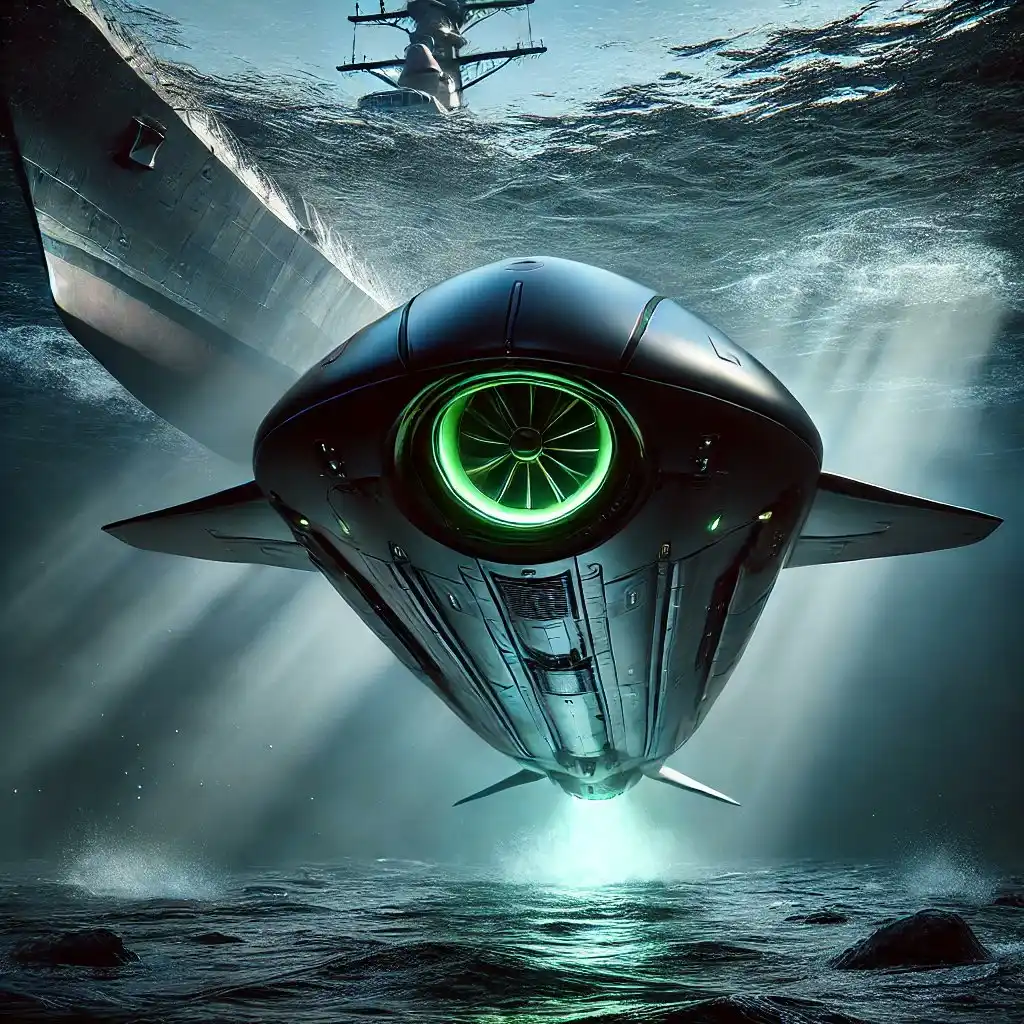
9. Ethical & Policy Considerations
-
International Law Compliance: Maritime Law & UNCLOS: Since TSPs can operate covertly across international waters, it is essential to align their deployment with the United Nations Convention on the Law of the Sea (UNCLOS). Clear protocols must be established to prevent accidental intrusion into sovereign waters and ensure respect for exclusive economic zones. Arms Control & Proliferation: The ability to carry anti-satellite weapons, hypersonic missiles, and advanced torpedoes presents a significant leap in destructive capability. Balancing deterrence with global nonproliferation goals is critical to preventing a new kind of arms race.
-
AI Accountability: Autonomous Engagement: While AI-driven targeting increases speed and precision, it also raises questions about human control and accountability. Ensuring meaningful human oversight — particularly for lethal actions — helps avoid unintended escalations and aligns with emerging norms on autonomous weapons systems. Cybersecurity & Data Integrity: TSPs rely on vast amounts of data to function autonomously. Robust encryption, anti-tamper measures, and contingency plans must be in place to prevent hacking or data corruption that could hijack the system or lead to catastrophic errors.
-
Environmental Stewardship: Minimal Ecological Disruption: Silent propulsion and low-impact operational footprints reduce damage to marine life, but large-scale TSP deployments still require careful environmental assessments. Monitoring programs should track any ecological changes, ensuring that defensive operations do not unduly harm ocean habitats.Sustainable Design & Disposal: From construction materials to end-of-life recycling or disposal, TSPs must be designed with sustainability at the forefront, limiting pollution and safeguarding biodiversity.
-
Transparency & Confidence-Building: Allied Collaboration: Sharing relevant operational data and coordinating with allies can prevent misunderstandings. Joint exercises and open communication build trust and encourage adherence to shared ethical standards.Multinational Frameworks: Establishing mutual agreements — within NATO, NORAD, or broader coalitions — helps standardize the rules of engagement, further reducing the risk of conflict escalation.
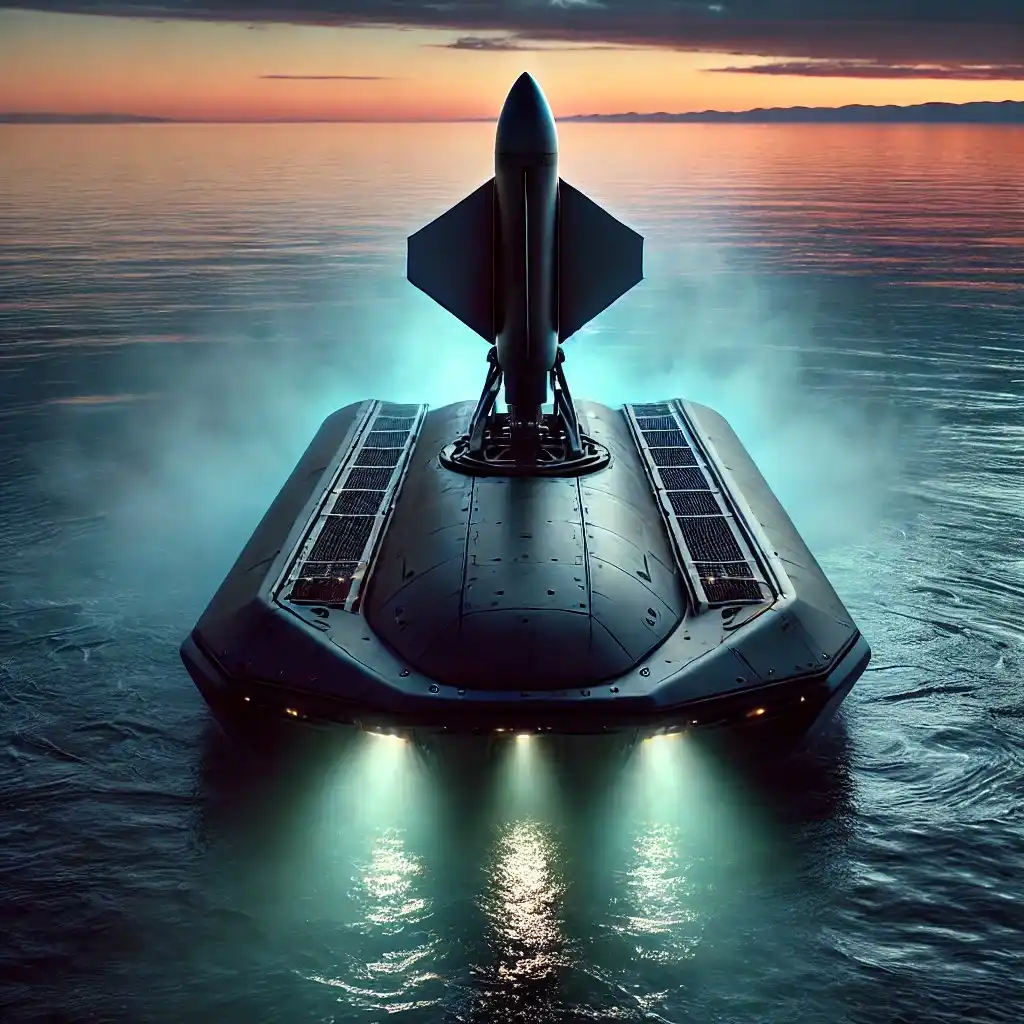
10. References & Further Reading
-
Maritime & Defense Studies: United Nations Convention on the Law of the Sea (UNCLOS) – United Nations, 1982 Maritime Power and the Law of the Sea – James Kraska, Oxford University Press, 2011 The Influence of Sea Power Upon History – Alfred Thayer Mahan, 1890 (classic strategic theory still relevant in discussions of naval dominance)
-
Hypersonic & Advanced Weaponry: Hypersonic Missile Nonproliferation – RAND Corporation, 2017 Emerging Military Technologies – NATO Science & Technology Organization, 2020
-
Autonomous Systems & AI: AI and National Security – Congressional Research Service (CRS Report), 2020 Lethal Autonomous Weapons Systems (LAWS): Strategic, Legal, and Ethical Perspectives – Stockholm International Peace Research Institute (SIPRI), 2021
-
Sustainability & Environmental ImpactMarine Ecosystems and Military Sonar: A Review – D. Nowacek et al., Marine Pollution Bulletin, 2020 Green Defense: Sustainability Initiatives in Military Operations – European Defence Agency, 2019
-
Naval Innovation & Strategy: The Future of Naval Warfare – US Naval War College, 2022 Distributed Lethality: Transforming the U.S. Navy – Proceedings Magazine, U.S. Naval Institute, 2015 Canadian Defence Policy and Maritime Strategy – Department of National Defence Canada, 2021

11. Conclusion

12. Select References
-
Kim, S. et al. (2022). Metamaterial Innovations for Naval Applications. Journal of Advanced Composite Research, 45(3), 215–235.
-
Ghasemi, A. & Li, Y. (2021). High-Temperature Superconductors in Maritime Propulsion Systems. International Review of Naval Science, 12(2), 99–113.
-
DARPA. (2020). Collaborative Autonomous Systems: Swarm AI Research. US Defense Advanced Research Projects Agency White Paper.
-
Oelrich, I. (2023). Hypersonic Trajectories and Targeting in Naval Warfare. Proceedings of the Institute of Aeronautics and Astronautics, 78(4), 311–326.
-
Mahan, A.T. (1890). The Influence of Sea Power Upon History, 1660–1783. Little, Brown, and Company.
-
UNCLOS. (1982). United Nations Convention on the Law of the Sea. United Nations Treaty Collection.
-
NATO. (2019). Maritime Security and Distributed Lethality: A Strategic Concept. NATO Allied Command Transformation Report.
Endnote on STEM Inspiration

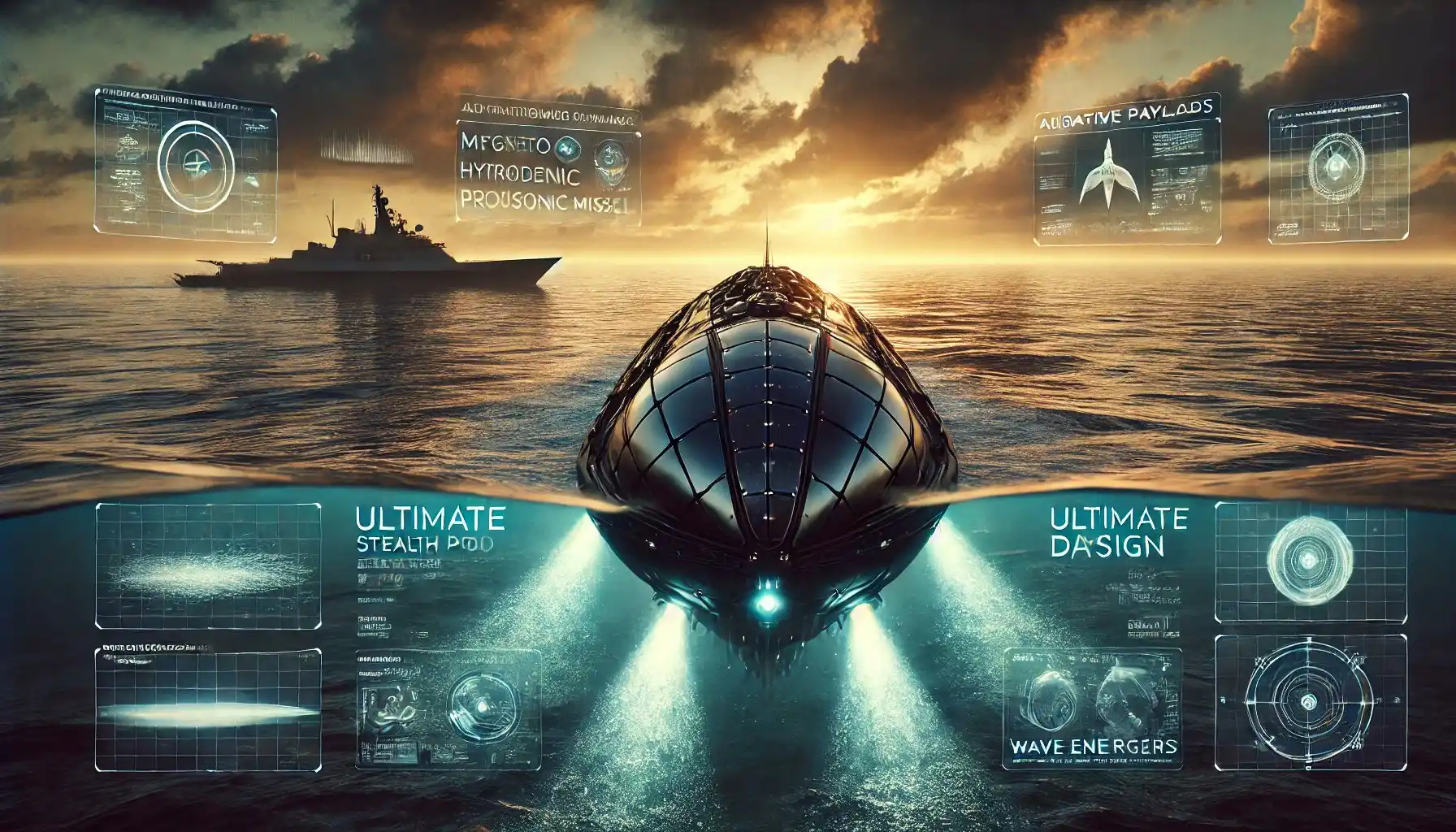
Related Content:
Title: “Hydrogen Fuel Cell-Powered UAVs: A Next-Generation Approach” https://x.com/SkillsGapTrain/status/1871536987942895782
Title: “Project AURORA AEGIS-X: The Ultimate Multi-Realm Guardian” https://x.com/SkillsGapTrain/status/1871150476416151751
Title: “Project BLUE THUNDER ‘Canada Edition’: The Future of Aerial Dominance” https://x.com/SkillsGapTrain/status/1871065353041903739
Title: “Blue Storm Rising” Master Report: A Comprehensive Framework for Alberta’s Industrial Miracle” https://x.com/SkillsGapTrain/status/1870763227300155891
Title: “Blue Storm Rising: A Canada-Wide Industrial Renaissance” https://x.com/SkillsGapTrain/status/1870617009823613062
Title: “Freedom Is the Heart of Canada’s Value — Don’t Let It Be Undermined” https://x.com/SkillsGapTrain/status/1870327584019317156
Title: “Beyond Skunk Works: Canada’s Modular Military Aerospace Revolution” https://x.com/SkillsGapTrain/status/1867668101413642376
Title: “Reclaiming the Skies: The Art & Science of Drone Defense” https://x.com/SkillsGapTrain/status/1863466993052971402
Title: “Blue Storm Rising: The Quiet Force Within” https://x.com/SkillsGapTrain/status/1862255032697045310
Title: “Canadians. Are our lives worth anything?” https://x.com/SkillsGapTrain/status/1871633391785017645
Title: “Colony | official trailer from Comic-Con 2015 Josh Holloway” https://youtu.be/bxglHSaRuKo?feature=shared
Title: “Project BLUE THUNDER ‘Canada Edition’: The Future of Aerial Dominance“ https://x.com/SkillsGapTrain/status/1871065353041903739
Title: “Beyond Skunk Works: Canada’s Modular Military Aerospace Revolution“ https://x.com/SkillsGapTrain/status/1867668101413642376
Title:“Project FRONTIER: Achieving Arctic Sovereignty & AI-Driven Naval Warfare Through Canada’s Enhanced Drone Ships from the VANGUARD Program” https://x.com/SkillsGapTrain/status/1867451481407795420
Title: “Project VANGUARD: Forging the Apex of Allied Maritime Dominance in the Age of AI, Swarms, & Hypersonics” https://x.com/SkillsGapTrain/status/1865782192154009811
Title: “TAP-IT 600 with Maglev & High-Speed Rail: The Foundation for The Next Generation Innovation, Industrial Growth, Industry 4.0, Technological Advancement, Naval & Space Systems, & National Security” https://x.com/SkillsGapTrain/status/1864351925787086957
Title: “Navigating the Future: Canada’s Strategic Transition to Next-Era Naval Platforms in the Revolution of Military Affairs” https://x.com/SkillsGapTrain/status/1863801158537453761
Title: “Reclaiming the Skies: The Art & Science of Drone Defense” https://x.com/SkillsGapTrain/status/1863466993052971402
Title: “The Ring of AI, Hope, Freedom & Fire: AeroSpaceX Vanguard, Aegis XXR, & Dawn of Autonomous Dominance” https://x.com/SkillsGapTrain/status/1860698877210554825
Title: “Project Arctic Arrow: Securing NATO’s Sovereignty with Transoceanic Aerospace Innovation from SpaceX & Alberta” https://x.com/SkillsGapTrain/status/1857500853453603278
Title: “The Return of the Arrow: Canada’s Next Generation Hybrid Ground-Effect Missile for the 21st Century” https://x.com/SkillsGapTrain/status/1857466940152741997
Title: “Human and Autonomous Synergy in Modern Warfare: Strategic Solutions for Canada’s Defense Vulnerabilities” https://x.com/SkillsGapTrain/status/1856124770317734244
Title: “AI and Armageddon: Unveiling the Epic Struggle Between Technological Dominion and Human Freedom” https://x.com/SkillsGapTrain/status/1847625815015461375
Title: “Echoes of Rebellion: The Rise of the Sovereign Guardians of Tranquility” https://x.com/SkillsGapTrain/status/1846554159727726697
Title: “Designing the Superior Fighting Force for the 21st Century: Integrating Blockchain Technology, Artificial Intelligence, Engineering Innovations, & Modern Military Strategies” https://x.com/SkillsGapTrain/status/1844981829750665720
Title: “Rediscovering Balance: Autonomy and Control in the Age of AI” https://x.com/SkillsGapTrain/status/1844696127012065791
To see our Donate Page, click https://skillsgaptrainer.com/donate
To see our YouTube Channel, click https://www.youtube.com/@skillsgaptrainer
